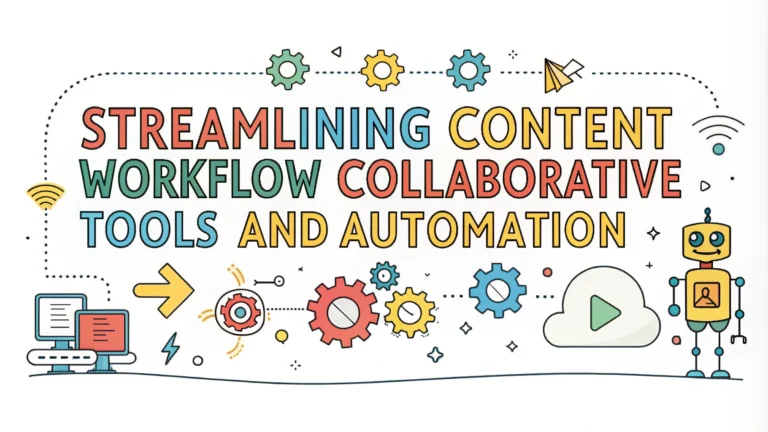Content creation teams face numerous challenges in today’s fast-paced digital environment. This article explores effective strategies for streamlining content workflows, focusing on collaborative tools and automation techniques. We’ll cover practical tips to boost productivity, enhance team management, and create more efficient content processes.
Understanding Content Workflows
Content workflows are the series of steps involved in creating, reviewing, and publishing content. An efficient workflow can significantly impact productivity and content quality.
- Key components: Ideation, creation, editing, approval, and publication
- Common bottlenecks: Unclear responsibilities, inefficient communication, manual tasks
Identifying areas for improvement in your current workflow is the first step towards optimization.
Leveraging Collaborative Tools
Collaborative tools play a crucial role in streamlining content workflows. They enable team members to work together seamlessly, regardless of location.
Project Management Platforms
- Trello: Visual board-based project management
- Asana: Task management and team collaboration
- Monday.com: Customizable workflow management
These platforms help teams track progress, assign tasks, and maintain transparency throughout the content creation process.
Content Creation and Editing Tools
- Google Docs: Real-time collaborative writing and editing
- Grammarly: AI-powered proofreading and editing
- Hemingway Editor: Readability improvement tool
Collaborative writing tools enable multiple team members to work on content simultaneously, streamlining the creation and editing phases.
Implementing Automation in Content Workflows
Automation can significantly reduce manual tasks and improve efficiency in content workflows.
Content Planning and Scheduling
- CoSchedule: Content calendar and social media scheduling
- Hootsuite: Social media management and scheduling
- Buffer: Social media post scheduling and analytics
These tools help teams plan, schedule, and distribute content across various platforms automatically.
Workflow Automation
- Zapier: Connect apps and automate workflows
- IFTTT: Create conditional automated actions
- Microsoft Power Automate: Build automated workflows across multiple applications
Workflow automation tools can handle repetitive tasks, freeing up time for more creative and strategic work.
Optimizing Team Management for Content Creation
Effective team management is essential for streamlining content workflows. Here are some strategies to improve team efficiency:
- Clear roles and responsibilities: Define each team member’s role in the content creation process
- Regular check-ins: Schedule brief meetings to discuss progress and address challenges
- Standardized processes: Create templates and style guides for consistency
- Feedback loops: Implement systems for continuous improvement based on team feedback
By optimizing team management, you can reduce bottlenecks and improve overall workflow efficiency.
Crafting an Effective Content Strategy
A well-defined content strategy forms the backbone of streamlined workflows. It provides direction and purpose to your content creation efforts.
- Audience research: Understand your target audience’s needs and preferences
- Content goals: Align your content with business objectives
- Content types: Determine the most effective formats for your audience
- Distribution channels: Identify the best platforms to reach your audience
A clear strategy helps teams focus on creating content that resonates with the audience and achieves business goals.
Content Calendar Creation
A content calendar is a powerful tool for organizing and planning your content creation efforts.
- Topic brainstorming: Schedule regular sessions to generate content ideas
- Content mapping: Align topics with your content strategy and audience needs
- Publishing schedule: Set realistic deadlines for each piece of content
- Team assignments: Allocate tasks to team members based on their strengths
A well-maintained content calendar ensures consistent output and helps prevent last-minute rushes.
Implementing Quality Control Measures
Quality control is essential for maintaining high standards in your content production.
Content Review Process
- Peer reviews: Implement a system for team members to review each other’s work
- Editorial checklist: Create a standardized list of quality criteria
- Fact-checking: Verify all information and sources before publication
- SEO optimization: Ensure content aligns with SEO best practices
A robust review process helps catch errors and improves the overall quality of your content.
Performance Tracking
Monitoring content performance provides insights for continuous improvement.
- Analytics tools: Use platforms like Google Analytics to track content metrics
- Key Performance Indicators (KPIs): Define relevant metrics for your content goals
- Regular reporting: Schedule periodic reviews of content performance
- Feedback integration: Use performance data to refine your content strategy
Performance tracking helps identify successful content types and areas for improvement in your workflow.
Training and Skill Development
Investing in team training enhances overall workflow efficiency and content quality.
Skill Assessment
- Individual evaluations: Identify strengths and areas for improvement
- Team skills matrix: Create a visual representation of team capabilities
- Gap analysis: Determine skills needed to meet content strategy goals
A clear understanding of team skills helps in task allocation and targeted training efforts.
Training Programs
- Writing workshops: Improve team members’ writing and editing skills
- Tool training: Ensure proficiency in content creation and collaboration tools
- SEO education: Keep the team updated on latest SEO practices
- Industry trends: Organize sessions on emerging content trends and technologies
Ongoing training keeps your team sharp and adaptable to changing content landscape.
Conclusion
Streamlining content workflows is an ongoing process that requires consistent effort and adaptation. By implementing these strategies, content teams can boost productivity, improve quality, and meet the demands of today’s fast-paced digital environment.
Key takeaways for optimizing content workflows:
- Develop a clear content strategy aligned with business goals
- Leverage collaborative tools and automation to increase efficiency
- Implement robust quality control measures
- Invest in ongoing team training and skill development
Remember, the goal is to create a workflow that not only increases productivity but also enhances the quality and effectiveness of your content. Regular evaluation and refinement of your processes will ensure your content team stays agile and competitive in the ever-evolving digital landscape.













